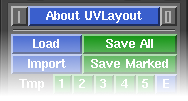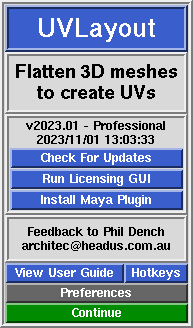User Guide: About UVLayout
From UVLayout Docs
(Difference between revisions)
| Revision as of 05:37, 20 October 2008 (edit) Headus (Talk | contribs) ← Previous diff |
Revision as of 08:37, 24 October 2008 (edit) (undo) Headus (Talk | contribs) Next diff → |
||
| Line 25: | Line 25: | ||
| ; Check For Updates {{Pro2|pro1|User_Guide:_Display#pro2}} : Click this button to check if there's a more recent version to the one you're currently running. This will open up a window in your default web browser, and if more recent versions are available, details about the new features and bug fixes will be displayed. | ; Check For Updates {{Pro2|pro1|User_Guide:_Display#pro2}} : Click this button to check if there's a more recent version to the one you're currently running. This will open up a window in your default web browser, and if more recent versions are available, details about the new features and bug fixes will be displayed. | ||
| - | ; Try Professional Version : Clicking this button will restart UVLayout in Professional version trial mode, with everything but the Save buttons enabled. This gives you the opportunity to test out all the features of UVLayout described in this User Guide and as shown in the training videos. | + | ; Run Licensing GUI : Opens up the headus licensing application, which will tells you various information about your system and any licenses you have. If you have a temporary license, it will also tell you how much time is left. |
| - | ; Try Hobbyist Version : Clicking this button will restart UVLayout in Hobbyist version trial mode. This gives you the opportunity to try out the features provided in that version of UVLayout. | + | ; Try Professional Version : This button will restart UVLayout in Professional version trial mode, with everything but the Save buttons enabled. This gives you the opportunity to test out all the features of UVLayout described in this User Guide and as shown in the training videos. |
| + | |||
| + | ; Try Hobbyist Version : This button will restart UVLayout in Hobbyist version trial mode. This gives you the opportunity to try out the features provided in that version of UVLayout. | ||
| ; View User Guide : Click this button to view a PDF version of the User Guide in your default browser. Its loading a file included in the software installation, so you don't need to be connected to the internet to view it. | ; View User Guide : Click this button to view a PDF version of the User Guide in your default browser. Its loading a file included in the software installation, so you don't need to be connected to the internet to view it. | ||
| Line 45: | Line 47: | ||
| :; Mouse Buttons : Sometimes UVLayout will get confused about the number of buttons your mouse has, particularly if you're on a laptop and are swapping between an external mouse in an inbuilt touch pad without completely rebooting. This may affect things like the Space-MMB or Ctrl-MMB actions to move shells and points around. You can use this setting to force UVLayout to treat the mouse as though it has the number of buttons you select. | :; Mouse Buttons : Sometimes UVLayout will get confused about the number of buttons your mouse has, particularly if you're on a laptop and are swapping between an external mouse in an inbuilt touch pad without completely rebooting. This may affect things like the Space-MMB or Ctrl-MMB actions to move shells and points around. You can use this setting to force UVLayout to treat the mouse as though it has the number of buttons you select. | ||
| - | :; Mouse Wheel : By default, the scroll wheel on a three button "wheel mouse" will zoom the view. If you want to disable this action, turn it off here. | + | :; Wheel Slider : Move the slider to the right to increase the power of a wheel mouse's zoom function. Move it to the left to decrease the power, and go all the way to the left to turn off the zoom function completely. |
| :; Double Tap : This sets the double tap speed, in seconds, for hotkey actions like the edge straightening '''Double-S'''. If you find you can't tap fast enough, increase this value. | :; Double Tap : This sets the double tap speed, in seconds, for hotkey actions like the edge straightening '''Double-S'''. If you find you can't tap fast enough, increase this value. | ||
| - | |||
| - | :; Enable LMB Edit : Turn this on to enable Ctrl-LMB edits of UV points, doing the exact same thing as Ctrl-MMB. Be warned though, in a future version we may want to use the Ctrl-LMB key combination for other things, and so this duplication of the edit action could be removed. | ||
| :; Set All UVs on Save : Normally only flattened polys will be saved with UVs. Enabling this preference will force UVLayout to assign a planar projection to any unflattened polys when the mesh is saved out to OBJ files. | :; Set All UVs on Save : Normally only flattened polys will be saved with UVs. Enabling this preference will force UVLayout to assign a planar projection to any unflattened polys when the mesh is saved out to OBJ files. | ||
| :; Undo Show : By default, Ctrl-Z Undo is enabled; the code is quite new and not extensively tested, so if you experience problems with it, click on the Undo button to turn it off. When Undo is enabled, the name of the previous action is displayed towards the top right of the graphics window, along with a small bar that indicates how full the Undo buffer is; to hide this information, click on the Show button to turn it off. The Undo buffer starts off at 100Mb, which means that UVLayout will use up to this amount of RAM when saving the undo restore information; if you are on a system with limited RAM, you may want to reduce this number, and conversely, increasing it on a larger system will give you more levels of undo. | :; Undo Show : By default, Ctrl-Z Undo is enabled; the code is quite new and not extensively tested, so if you experience problems with it, click on the Undo button to turn it off. When Undo is enabled, the name of the previous action is displayed towards the top right of the graphics window, along with a small bar that indicates how full the Undo buffer is; to hide this information, click on the Show button to turn it off. The Undo buffer starts off at 100Mb, which means that UVLayout will use up to this amount of RAM when saving the undo restore information; if you are on a system with limited RAM, you may want to reduce this number, and conversely, increasing it on a larger system will give you more levels of undo. | ||
| - | |||
| - | :; Show Old GUI Controls : To keep the GUI as clean as possible, buttons that may still do something are removed if they've been superseded by newer functions. If you preferred the old way of doing something, tick this option to show those old buttons. | ||
| :; Max Shells : When an OBJ file is loaded in '''Edit''' mode, the number of UV shells is checked first; if there's more than this setting, the load is aborted and a message is displayed suggesting that the '''Weld UVs''' load option might be needed. If your mesh really does have more than the default of 2000 shells (e.g. individual leaves on a tree) then you can increase the shell limit here. | :; Max Shells : When an OBJ file is loaded in '''Edit''' mode, the number of UV shells is checked first; if there's more than this setting, the load is aborted and a message is displayed suggesting that the '''Weld UVs''' load option might be needed. If your mesh really does have more than the default of 2000 shells (e.g. individual leaves on a tree) then you can increase the shell limit here. | ||
| Line 64: | Line 62: | ||
| :; Slow Smooth Optimize : By default this is on, and it means that when the '''Optimize''' is run, shells are redrawn at every flattening optimization step. This makes it look nice and smooth when its running, but the continuous redrawing does use a significant chunk of available CPU. By turning this off, the optimize will only redraw shells twice a second; even though it looks slower, the CPU is now spending more time flattening, and so it'll get to the optimal result quicker. | :; Slow Smooth Optimize : By default this is on, and it means that when the '''Optimize''' is run, shells are redrawn at every flattening optimization step. This makes it look nice and smooth when its running, but the continuous redrawing does use a significant chunk of available CPU. By turning this off, the optimize will only redraw shells twice a second; even though it looks slower, the CPU is now spending more time flattening, and so it'll get to the optimal result quicker. | ||
| + | |||
| + | :; Show Old GUI Controls : To keep the GUI as clean as possible, buttons that may still do something are removed if they've been superseded by newer functions. If you preferred the old way of doing something, tick this option to show those old buttons. | ||
| :; Restore GUI Panels : If you turn this on, then panels opened up when you exit UVLayout are reopened the next time UVLayout is run. | :; Restore GUI Panels : If you turn this on, then panels opened up when you exit UVLayout are reopened the next time UVLayout is run. | ||
| + | |||
| + | :; GUI Always on Top : Turn this on to force the GUI windows to always stay on top of the 3D window if they're overlapping. ''Linux and Mac OS X only.'' | ||
Revision as of 08:37, 24 October 2008
|
UVLayout is a stand-alone application for the creation and editing of UV coordinates for 3D polymeshes and subdivision surfaces. Used by professionals in the games and visual effects industries, by hobbyists of all ilks and by students, UVLayout's unique approach gives texture artists the tools they need to produce high quality low distortion UVs in significantly less time than they would by traditional methods.
Over the following pages the UVLayout GUI will be described, working from the top to the bottom of the main window. Use the menu to the left to move through the various chapters. If you want to jump right into using UVLayout, you should at least read the Quick Start chapter. Note: Sections tagged with a [Professional Version Only] label describe features only available in the Professional version of UVLayout. Click on the [Professional Version Only] link to cycle through these sections. The top row of the UVLayout main window (see image right) consists of three buttons:
When you click on the About UVLayout button a window (see image right) pops up, showing the version and build date of the UVLayout that you are currently running.
|

